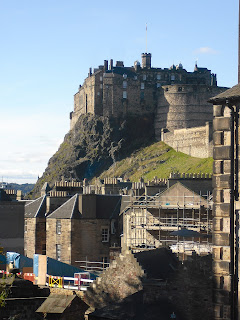Wales
 |
| Conwy Castle from the middle of the town |
 |
| Interior of Conwy Castle -This was the great hall with a chapel in the rear |
Conwy - A
walled town in northern Wales with attached castle. It is amazing because the wall still
surrounds the original town and 90% of it can be walked. Northern Wales has an abundance of medieval
castles that are in remarkable condition for a being 700-800 years old. This
means the walls are left and you can climb up to the top of many towers as well
as walk on the top of the castle walls. The
walls have mid-level corridors that allowed defenders to travel quickly the
length of the walls and defend them as needed.
 |
View of walled town from Conwy Castle
|
These
castles (17 of them) were built by King Edward to support his claim to Wales and secure his
safety and that of his supporters while here. The towns were built and filled
with English settlers. The Welsh were not allowed to live or often enter the
towns. The castles were all built with
multiple rings of fortifications as well as secure access to the sea for
delivery of supplies.
 |
Wide tidal difference - Harbor at low tide
|
Along the harbor wall toward the city wall jutting into the harbor in the distance is the smallest house in England. It is two floors built against the city wall with a fireplace, sitting bench ladder and single bed upstairs. You can stand up inside. It has fairly high ceilings.
 |
| Kathy coming out of smallest house |
We had a
beautiful weekend in Wales spending one day in Conwy, castle, town and wall and
a day visiting Beau Maris and Caernarfon castles. We drove home through the mountains of
Wales. They are made of slate quite
steep, rocky and beautiful. The tallest is Mt Snowdon at 3560 feet.
Beau Maris
Castle still has its moat around ¾ of the castle. The protected dock for ships
is evident. King Edward stayed here with his wife even though it was never
finished.
 |
| Front of Beau Maris Castle wooden walk was draw bridge |
 |
| View of secure harbor to right of main entrance(wall is gone) |
 |
| Midlevel walk inside castle wall - light from alcoves with arrow slit |
Beau Maris Castle is on an island seperated from the main island by Menai strait. Before this bridge ws built in the late 1800's it took three hours to cross this strait on the way to Dublin.
The tidal shift in this strait is dramatic. Boats are equiped with fins to keep them upright when the tide is out.
Caernarfon
castle is the place where the next in line for the British throne is vested
with the title of Prince of Wales. It is the largest of the castles, but like
Beau Maris was never totally finished due to wars in Scotland that needed
attention.
 |
Main castle entrance
|
 |
| View from West end inside the castle. |
Caernarfon had water pipes in the castle. The two well sites had sinks to dump water when it was pulled up and this water would drain to the kitchens or where it was needed. This view of the kitchen, below, shows in the background the grove where the water pipes were. The lead has been stolen long ago. On the left are two caldren/ kettle stands for cooking.




















































